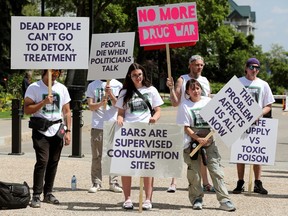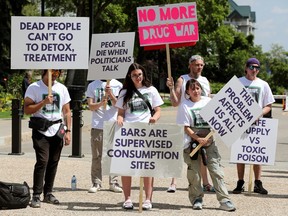Breadcrumb Trail Links
Columnists
Published Oct 04, 2023 • 3 minute read
You can save this article by registering for free here. Or sign-in if you have an account.
 Edmontonians gather outside the Alberta Legislature during a rally calling for the Province to move to a safe supply and safe consumption model instead of forced rehabilitation for Albertan’s experiencing drug addictions, in Edmonton Monday June 26, 2023. Photo by David Bloom /Postmedia
Edmontonians gather outside the Alberta Legislature during a rally calling for the Province to move to a safe supply and safe consumption model instead of forced rehabilitation for Albertan’s experiencing drug addictions, in Edmonton Monday June 26, 2023. Photo by David Bloom /Postmedia
Article content
Alberta Premier Danielle Smith’s mandate letter to Minister of Mental Health and Addiction Dan Williams, asks for an “Alberta Model” and a directive to “develop compassionate intervention legislation, supporting facilities and legal processes to save the lives of those who are a danger to themselves or others.”
The idea behind the proposed legislation is to “give police and family members or legal guardians of drug users the ability to refer adults and youth into involuntary treatment if they pose a risk to themselves and others.” Criticism of the plan was swift. One advocate for harm reduction noted that “Forced treatment is not a service provision; it’s just incarceration by another name.”
Advertisement 2
This advertisement has not loaded yet, but your article continues below.
THIS CONTENT IS RESERVED FOR SUBSCRIBERS ONLY
Subscribe now to read the latest news in your city and across Canada.
Exclusive articles by David Staples, Keith Gerein and others, Oilers news from Cult of Hockey, Ask EJ Anything features, the Noon News Roundup and Under the Dome newsletters.Unlimited online access to Edmonton Journal and 15 news sites with one account.Edmonton Journal ePaper, an electronic replica of the print edition to view on any device, share and comment on.Daily puzzles, including the New York Times Crossword.Support local journalism.
SUBSCRIBE TO UNLOCK MORE ARTICLES
Subscribe now to read the latest news in your city and across Canada.
Exclusive articles by David Staples, Keith Gerein and others, Oilers news from Cult of Hockey, Ask EJ Anything features, the Noon News Roundup and Under the Dome newsletters.Unlimited online access to Edmonton Journal and 15 news sites with one account.Edmonton Journal ePaper, an electronic replica of the print edition to view on any device, share and comment on.Daily puzzles, including the New York Times Crossword.Support local journalism.
REGISTER / SIGN IN TO UNLOCK MORE ARTICLES
Create an account or sign in to continue with your reading experience.
Access articles from across Canada with one account.Share your thoughts and join the conversation in the comments.Enjoy additional articles per month.Get email updates from your favourite authors.
Sign In or Create an Account
or
Article content
Article content
Given the public debate — frustrations by some parents and guardians who have tried all they could and profound concerns of harm reduction advocates and professionals — the question is: Does involuntary treatment work? What or where is the evidence?
While this appears like a novel idea, there is evidence it has been around from at least the second half of the 19th century. Such treatment — i.e. “secure care” — is already in the books for youth in at least seven provinces in Canada. These are Alberta, Manitoba, New Brunswick, Nova Scotia, Ontario, Quebec and Saskatchewan. The evidence about its effectiveness is mixed.
For example, a 2018 paper based on the British Columbia context argues, “Although secure care may prove effective for select youth with strong supports, the evidence for mandatory treatment is weak.” The paper notes a meta-analysis indicating lack of “significant improvements in substance use during or after treatment.” The paper cautions against the risk of overdose post-release. However, a paper in the McGill Journal of Health Law argues, “in the provinces where youth secure care legislation does not exist, mental health institutionalization and the youth criminal justice system tends to fill in the gaps where other social and health services fail.”
Headline News
Thanks for signing up!
Article content
Advertisement 3
This advertisement has not loaded yet, but your article continues below.
Article content
Mental Health and Addiction Minister Williams referenced Portugal and Massachusetts in his public response. Therefore, evidence from those two jurisdictions may be helpful to chart the course in Alberta.
A 2020 paper in the Journal of Law, Medicine & Ethics draws on the Massachusetts context. In it, Farhad R. Udwadia and Judy Illes analyze the ethicolegal issues. For example, the uncertainty regarding whether “the standard of a likelihood of serious harm is high enough to justify the degree of invasiveness of the intervention.”
They note that there was an 85-per-cent increase in the use of the involuntary treatment law (Section 35) in Massachusetts between 2010 and 2017 with an approval rate of 58 per cent in 2016-2017. These were generally 90-day commitments.
The authors argue that there is “no documented medical evidence to date that suggests that this particular length of time is effective with regards to the treatment of addiction disorders. The mandate thus seems to be arbitrary, depriving individuals of their liberty for a period of time that is scientifically unfounded.” The paper cites several other studies regarding “potential harms” and raises questions about the liberty, privacy and dignity of the persons committed.
Advertisement 4
This advertisement has not loaded yet, but your article continues below.
Article content
Udwadia and Illes state a finding that may give pause regarding outcomes in Massachusetts: “people who are involuntarily committed under the Section 35 pathway are at a 2.2 times greater risk of overdosing post-release relative to those who are voluntarily treated.” This finding comes from a 96-page report released by the Massachusetts government.
How has Portugal fared? One relatively dated study gives a picture of those involuntarily committed to a psychiatric hospital in Portugal between 2005 and 2006. It examines 456 admissions. The study concludes that the cases coalesce around this profile: “a middle-aged, unmarried man, unemployed, with the diagnosis of schizophrenia without co-morbid substance abuse, who is taken to hospital by the authorities due to aggressive or violent behaviour, and needs treatment in hospital for about three weeks.” We must be careful about context comparisons. We must be certain if this is the same demographic or condition the proposed law seeks to target.
Finally, missing supports should be provided before individual mental conditions are exacerbated. We need to allow science and experts to lead the way as we deal with mental health crises and random acts of violence.
Temitope Oriola is professor of criminology at the University of Alberta and the 2023 recipient of the Gerald L. Gall Human Rights Award. Email: oriola@ualberta.ca X: @topeoriola
Article content
Share this article in your social network

